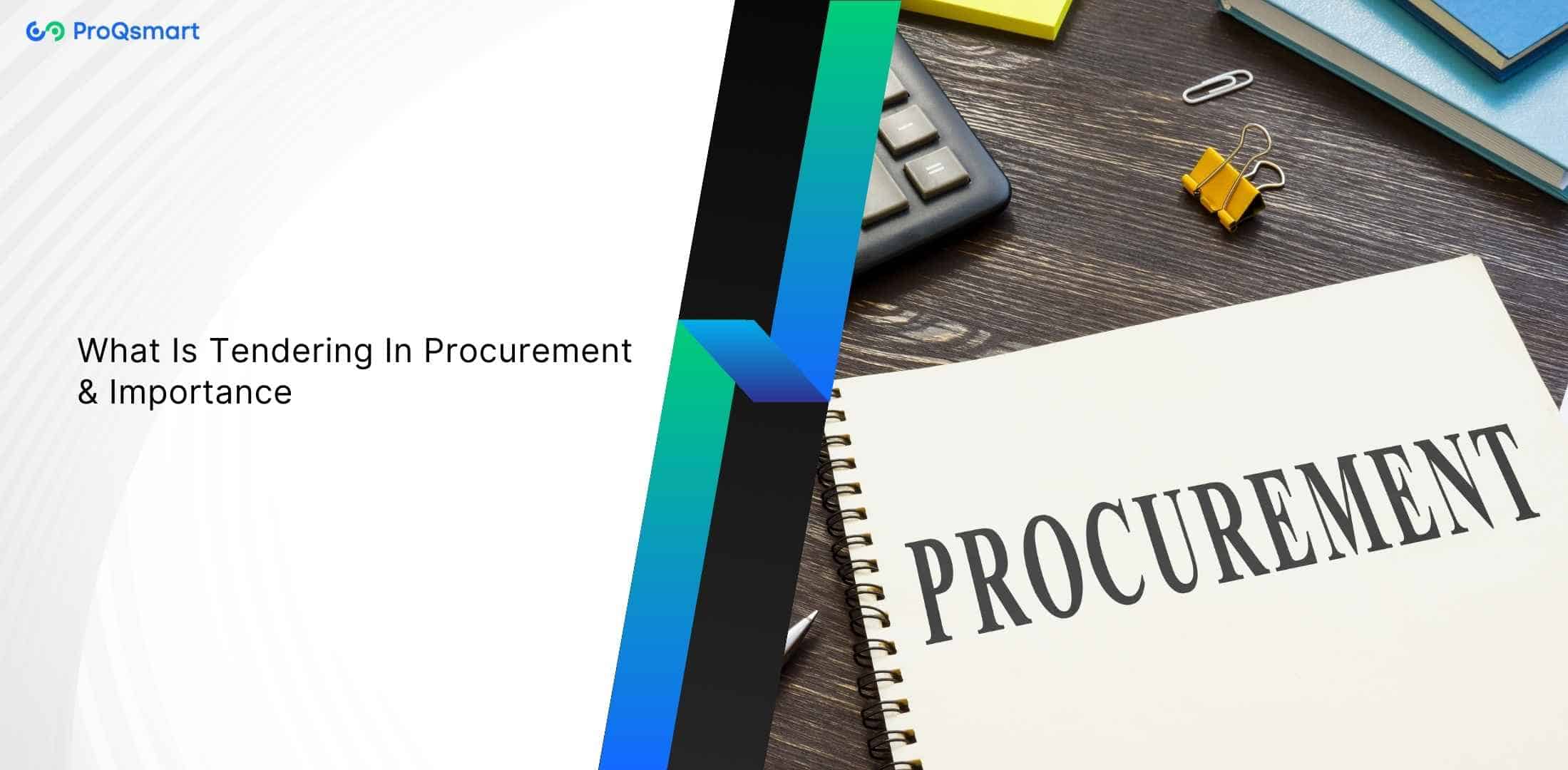Tendering in procurement creates an important foundation of the procurement process. It establishes a transparent and competitive process to acquire goods and services. It helps maintain competitive pricing and quality by ensuring bids are received from multiple suppliers.
Getting to know these factors can go a long way toward creating a positive ripple effect on your procurement strategy. By prioritizing fundamental measures and proven methods, you’ll improve outcomes, make better decisions, and get the most out of your limited resources.
It’s a question of smart prioritization and procurement decisions that further the missions of their organizations, resulting in improved performance and long-term prosperity.
Key Takeaways
- Tendering in procurement is a formal, transparent process that purposefully solicits and compares competitive bids from potential suppliers. This approach encourages a transparent and fair process to promote competitive pricing and quality in all procurement activities. This structured process not only contributes to lower costs but improves supplier relationships and ensures adherence to regulations.
- The tendering process is central to our procurement policy. It not only leads to large cost savings, it mitigates risks by ensuring full compliance with regulations. This increases competition between suppliers further, helping organizations get even more value for their money.
- The tendering process provides transparency, communication, and definitive evaluation criteria, helping to ensure a competitive and orderly process to select right suppliers. Technology is an important factor in simplifying this process, making it not only more efficient, but more accessible.
- Good tendering means strict documentation, keeping to schedules, and ensuring transparency and accountability. These features are absolutely essential if we are to get the best possible results from our procurement activity.
- Different tender types, from open, to restricted, to competitive dialogue, allow for a great degree of flexibility. That’s because they’re uniquely designed to serve a variety of procurement needs. Each type brings distinct benefits, enabling organizations to select the best, most effective, and efficient approach for their projects.
What Is Tendering in Procurement?

Definition and Overview
Tendering in procurement generally refers to a formal process of inviting bids from potential suppliers. To begin the tendering process, the Buyer issues a formal Tender . In reply, Suppliers send in their bids. This method is at the heart of procurement, acting as the primary tool for purchasing goods or services.
The two core purposes of tendering are to ensure the best price through competition and to provide quality work. It seeks to promote transparency and fairness in awarding contracts. There are numerous benefits to structured tendering.
It reduces risk through comprehensive review and helps ensure you receive the most value for your dollar. Besides, by promoting an environment of healthy competition through the tendering process, we can award these valuable contracts more objectively – on the merits.
It’s especially common in sectors such as construction, IT, and consulting.
Importance in Purchasing Process
At the same time, tendering is a key part of the purchasing process that helps drive significant cost savings. Secondly, it encourages tenderers to comply with regulations and improves risk management by outlining criteria for evaluating bids.
Tendering brings competition between suppliers to deliver the best possible price and quality. This mechanism means Buyers can develop long-term, stable relationships with their Suppliers, who tender on the work to create a stable pipeline of work.
Tendering forms a large part of the overall procurement portfolio, representing over $60 billion per year. It is just one piece of the broader procurement puzzle. Ultimately, tendering is a model of a level playing field, open, competitive process for awarding contracts.
How Tendering Works
The tendering process starts when a government or organization announces a project or requirement and invites interested suppliers to bid on it. This first step is important because it lays the foundation for transparency and competition. After the bids are in, we go full force into bid evaluation.
We dig deep into major criteria such as cost, quality, experience, and ability to meet specifications in an actual construction project. In theory, review bids on a project by judging the contractor’s past successes. Further, look at them for safety and cost-effectiveness.
Clear communication is essential throughout this process to ensure all parties understand expectations and requirements, minimizing misunderstandings and ensuring smooth progress.
Technology has revolutionized the tendering process, automating aspects such as document submission, compliance checks, and bid evaluation. Online platforms allow for instant updates and streamlined access to information, creating a much more nimble and efficient process.
Additionally, electronic tendering systems make it easier to supply and submit bids electronically, cutting down on paper waste and increasing access for diverse suppliers.
Key Features of Tendering
Successful tendering is reliant on some important elements. One of the most important is detailed documentation, which leaves behind a clear paper trail of every submission and decision taken.
Timelines and deadlines are key, making sure that all bidders know that everyone must stick to the timeline, upholding transparency and responsibility. Clarity, transparency, and as well as accountability are key components to this, building public trust and integrity into the process.
Participants in Tendering
The tendering process is a huge ecosystem, with buyers, suppliers, and often internal and external consultants. In project tendering, buyers specify what they want but suppliers compete through bids.
An independent expert benchmark helps raise consultants’ expertise to better evaluate bids. Collaborative engagement between all participants leads to better outcomes, making sure that every perspective is heard and also the best decision is found.
Procurement Policies Impact
Public sector procurement policies play a major role in determining and upholding a fair and sound tendering process with anti-corruption measures. How these policies are structured will either promote competition or kill it.
Their design is fundamental to ensuring that the tendering process is successful and equitable.
Types of Tenders
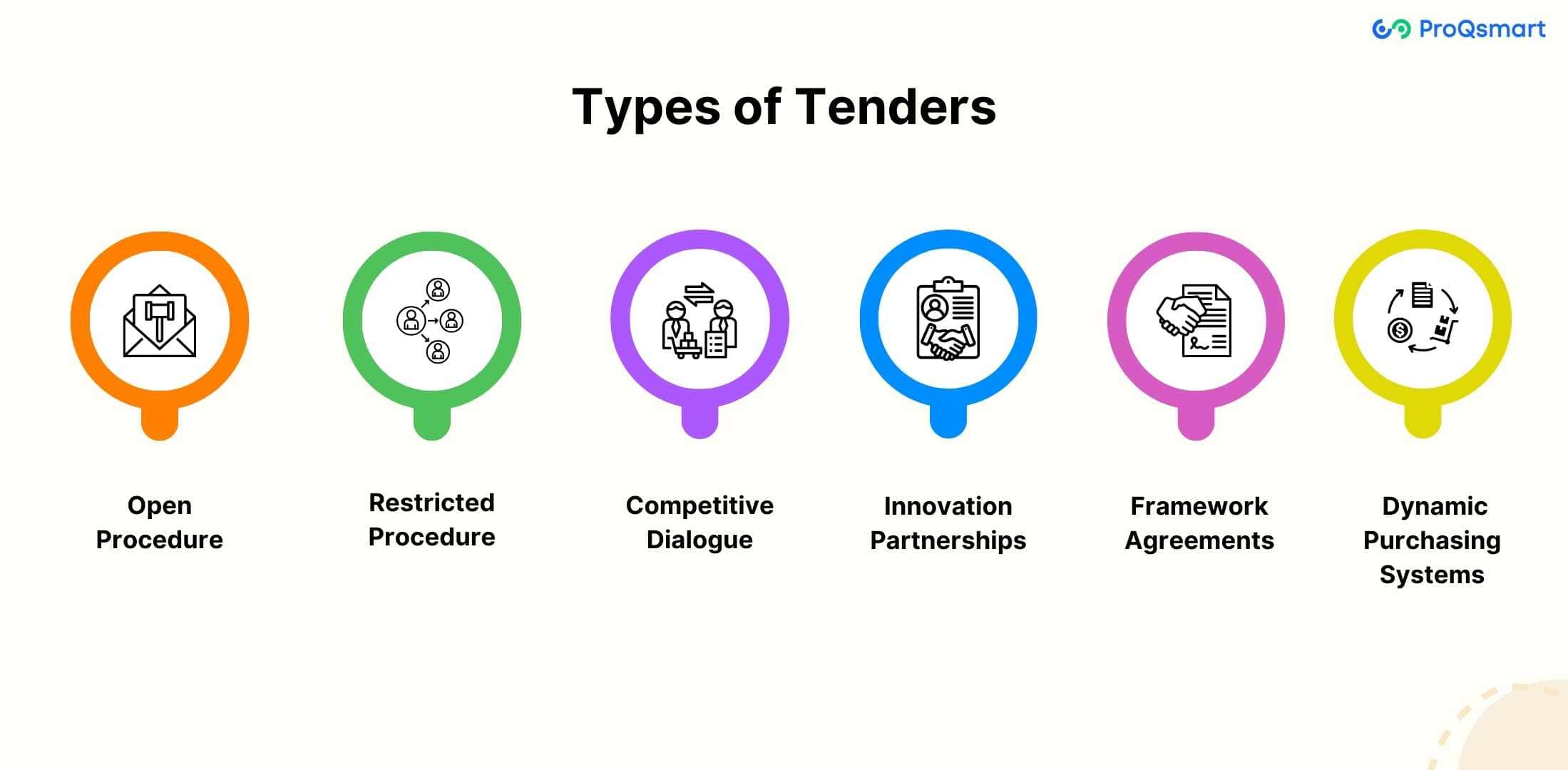
Here’s a comprehensive table to help categorize public procurement methods.
Tender Type | Features |
Open | Transparent, open to all qualified suppliers |
Restricted | Selective, limited to pre-qualified suppliers |
Negotiated | Involves pre-contract and post-contract negotiations |
Two-Stage | Used for complex projects, breaks contract into two phases |
Framework | Long-term agreements, flexible for future purchases |
Dynamic Purchasing | Ongoing engagement, open for suppliers to join anytime |
1. Open Procedure
The open procedure is the most accessible as it invites bids publicly and transparently, so any qualified supplier can bid. This inclusivity encourages better competition and innovation.
Yet, handling so many bids at once can be difficult. Setting transparent evaluation criteria from the outset helps avoid awkwardness later on and helps you identify the best supplier.
2. Restricted Procedure
The selective tendering process starts with a pre-qualification stage, which filters the field down to the suppliers who are able to meet the requirements.
This targeted approach is more efficient and cost-effective, saving taxpayer dollars by zeroing in on those who do not meet the high standards. Fairness is essential to upholding the integrity of the selection process.
3. Competitive Dialogue
Competitive dialogue is appropriate for the most complex projects, encouraging cooperation and discussion between procurer and contractor.
Its collaborative meetings keep discussions focused on customized solutions, improving project results and developing long-lasting collaborative partnerships.
4. Innovation Partnerships
Innovation partnerships are predicated on a longer-term relationship, with a greater focus on mutual objectives and iterative processes.
Together, these partnerships foster value, efficiency and demand collaboration, creating fertile ground for innovative solutions.
5. Framework Agreements
Framework agreements create longer-term agreements with suppliers allowing for easy procurement in the future as needs arise.
With pre-approved suppliers, your organization can source quickly, cut down procurement processes and be prepared for those surprise demands.
6. Dynamic Purchasing Systems
Dynamic Purchasing Systems (DPS) offer flexible tools for continued supplier engagement, allowing governments to respond to a changing supplier market.
Unlike framework agreements, a DPS is always open, so new suppliers can join and take part at any time.
It is where technology comes in as an indispensable tool to help operate these systems in a more efficient manner.
Competitive vs Non-Competitive Tenders
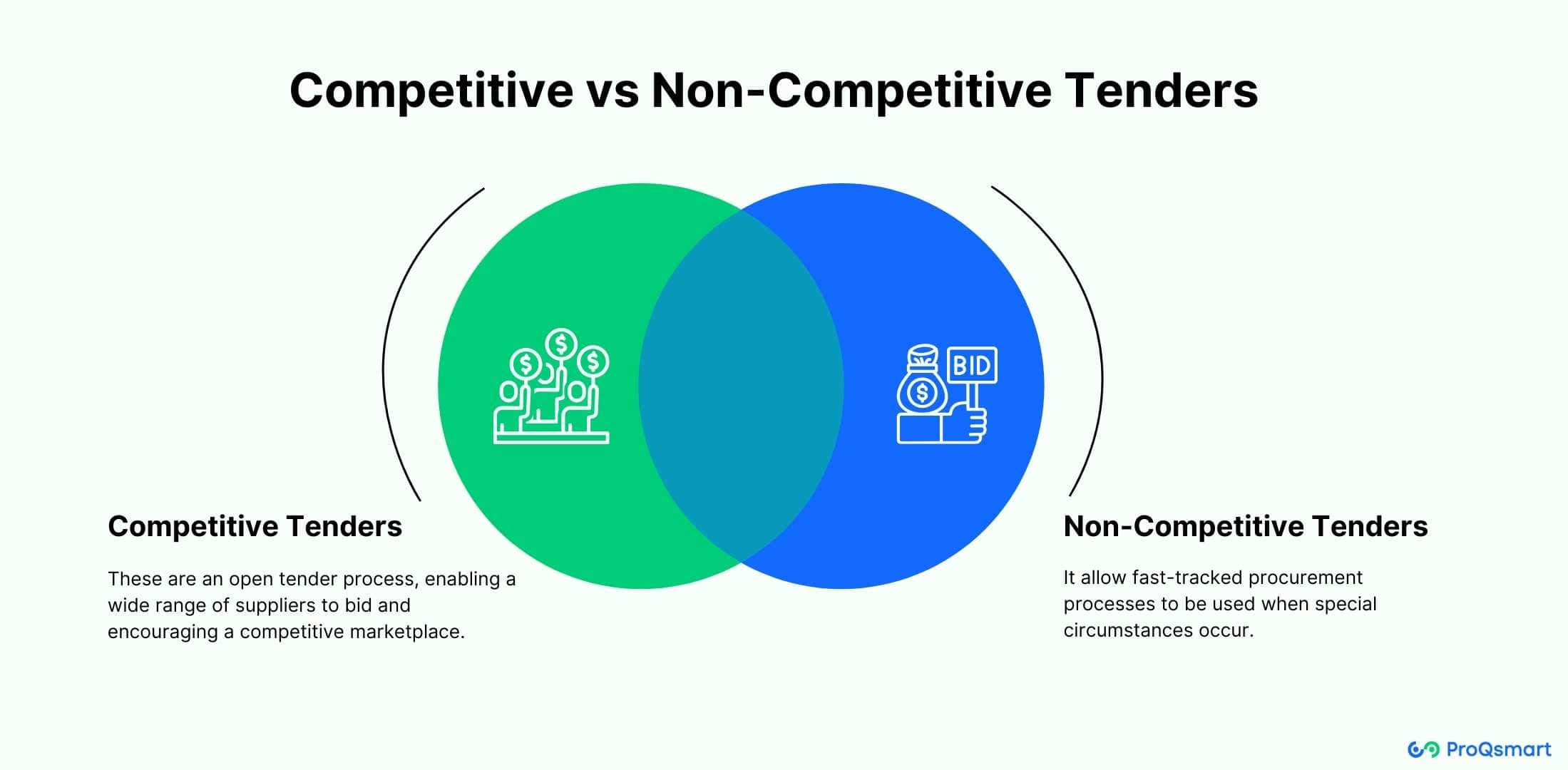
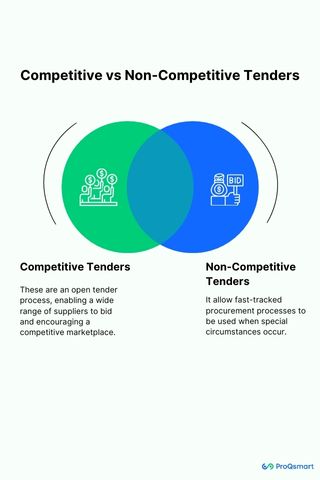
In today’s procurement landscape, understanding the differences between competitive tender and non-competitive tender methods is key to making the best decisions. Each procurement method has its own unique features and benefits, catering to diverse procurement requirements.
Characteristics of Competitive Tenders
Competitive tenders have important characteristics that distinguish them. These are an open tender process, enabling a wide range of suppliers to bid and encouraging a competitive marketplace. Competitive tendering helps to ensure that the process is transparent and fair.
It provides the kind of level playing field that truly fosters competitive participation by suppliers. We do it through highly specific evaluation criteria to choose the best overall proposal. Even better, this approach drives innovation, because suppliers want to win; they need to meet our high standards—or exceed them.
In a Dutch auction for Treasury securities, where we have large institutional buyers, they place competitive bids. This process significantly gives them the ability to collude on pricing, leading to poor price quality outcomes.
Characteristics of Non-Competitive Tenders
Non-competitive tenders allow fast-tracked procurement processes to be used when special circumstances occur. They are great when specialized knowledge is required. These tenders are open to the public and assist investors in purchasing U.S. Treasury securities.
Small investors can also participate without incurring prohibitive brokerage costs through Treasury Direct. While expediting procurement is a clear benefit, non-competitive procurement can also pose risks like inflated pricing and decreased quality.
Therefore, to use non-competitive approaches, justifying their use becomes crucial in order to hold decision-makers accountable and provide transparency in procurement decisions.
Feature | Competitive Tenders | Non-Competitive Tenders |
Transparency | High, with detailed evaluation criteria | Limited, requires justification |
Supplier Participation | Encouraged through fair and open processes | Restricted to specific needs |
Pricing and Quality | Driven by competition, often leading to better outcomes | May lack competitive pricing pressures |
Typical Use Cases | Large-scale, where innovation is desired | Urgent needs or unique expertise |
Competitive Tenders and Innovation
Competitive tenders intrinsically encourage innovation because of the wide array of suppliers competing to offer the most effective solutions. When suppliers compete, they significantly push the boundaries of creativity and efficiency to stand out, leading to innovative solutions that can transform procurement outcomes.
This competitive environment helps to ensure that organizations can take advantage of the most advanced technologies and most effective methods, improving the overall effectiveness of procurement.
Non-Competitive Tenders: When They Fit
Non-competitive tenders are appropriate when expertise is not readily available through a competitive process. Additionally, they work best when there is a short timeframe and urgent procurement is required.
As an example, the Treasury’s non-competitive bids enable smaller investors to participate without having to pay a bid-ask spread, improving their access to government securities. This type of dependence can also be risky where a lack of real competition exists.
Quick procurement and accessing specialized expertise are often such an advantage that this approach is worth it. It’s important, too, to keep the transparency and accountability that should go along with non-competitive tenders so they can do their intended purpose while still protecting quality.
Competition's Impact on Pricing and Quality
The presence of competition in tendering significantly impacts pricing and quality by introducing checks and balances that prevent monopolistic practices. Competitive environments force suppliers to put forth their most competitive pricing while maintaining the highest level of quality.
As we see in Treasury auctions, competition establishes fair market pricing, a win-win for the issuer and investor alike. Thus, this dynamic not only helps ensure cost-efficiency but it fosters a culture of constant innovation in the goods and services provided.
Tender vs Tender Offer
In government procurement, understanding the difference between a competitive tender and a tender offer is crucial. A tender is a formal invitation issued by a public or private organization, encouraging potential suppliers or contractors to submit their proposals for a defined project or service. This process is consistent across both public sector contracts and also private sector projects, ensuring a fair and competitive environment that protects the public interest.
A procurement document often includes detailed specifications, terms, and also conditions, allowing suppliers to provide their competitive bids. Meanwhile, clarity in these specifications is vital for effective procurement procedures, ensuring that all bidders understand the requirements, which minimizes confusion and potential disputes.
On the other hand, a tender offer serves as a significant tool for corporate acquisitions. It also allows an investor or company to procure a substantial block of another company’s shares directly from shareholders. This process is also overseen by the Securities and Exchange Commission (SEC), can be costly due to attorney and filing fees, making it a strategic move in the realm of business.
Tender offers are particularly powerful in executing hostile takeovers. In such scenarios, acquirers—often hedge funds or private equity firms—craft enticing offers to purchase shares at a premium, thereby attracting potential bidders. Thus, the swift execution of tender offers, typically concluding in less than a month, presents investors with attractive returns while mitigating risk.
Explanation of Tender
In procurement, a tender is an invitation to submit a proposal or bid. It intends to finish a designated project, or provide needed products or services. Meanwhile, this document serves to define the project’s scope, requirements, timelines and evaluation criteria.
The tendering process provides value for money and quality guarantee, as suppliers are motivated to submit their best proposals. Good tender documents include clear specifications and good evaluation criteria, cornerstones to a smooth procurement process. Moreover, providing clarity limits confusion, creates mutual understanding of expectations, and allows for fair evaluation of proposals.
Explanation of Tender Offer
A tender offer is not to be confused with procurement tenders. It’s primarily concerned with the pursuit of a controlling interest in a company through a direct purchase of that interest from shareholders. This strategy is frequently used in hostile mergers and acquisitions, in which the acquirer party is attempting to take control of the target quickly.
Given legal and financial implications, the SEC requires disclosure for tender offers above 5% of a company. These offers can be laden with escape clauses that limit risk for the acquirer. They typically offer a market premium, a price above the current market value, to entice shareholders to sell their shares.
Examples and Differences
For instance, a manufacturing company may invite suppliers to tender on the provision of raw materials for their production line. In contrast, a construction company may launch a tender offer to acquire a stake in a rival construction firm.
The primary difference between these two scenarios lies in their objectives. Tenders, like the manufacturing company’s invitation to suppliers, aim to procure goods or services. On the other hand, tender offers, like the construction company’s bid to acquire a stake in a rival firm, are about acquiring ownership or a significant stake in another company.
Stages of the Tender Process

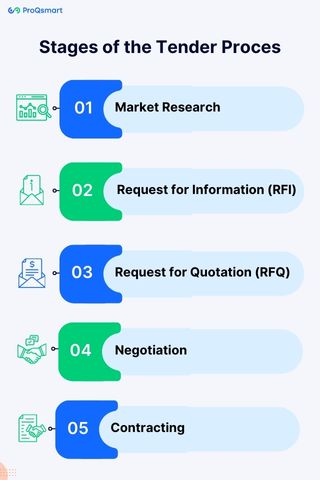
The competitive tender process in procurement is a highly structured approach, ensuring transparency and competitiveness throughout various stages.
- Market Research
- Request for Information (RFI)
- Request for Quotation (RFQ)
- Negotiation
- Contracting
Market Research Stage
This first stage lays the groundwork. It helps to reveal market dynamics and supplier capabilities, seeking to ensure the tender aligns with the buyer’s requirements.
By knowing what’s trending in the market, as well as the particular strengths of suppliers, a targeted tendering strategy can be developed. Data analysis is key here, too, identifying the right suppliers to invite to bid based on metrics like past performance and reliability.
Request for Information Stage
The RFI stage is essential in gaining key RFI intelligence into suppliers’ capabilities. It demystifies offerings, opening the door for empowered, informed decisions.
Well-articulated RFI documents are critical, setting the stage for the entire tender process and ensuring that only those suppliers that best fit the required criteria move forward.
Request for Quotation Stage
During the RFQ stage, suppliers bid against each other with their most aggressive pricing. This helps streamline the bidding process so that the emphasis is placed on quality and cost.
Looking at quotes through these lenses, not just price, delivers best value for money and adheres to the MEAT (Most Economically Advantageous Tender) principle.
Negotiation Phase
Negotiation is key, always to get the best terms. Strong lines of communication are essential, leading to improved terms of the contract.
Ultimately, flexibility and collaboration in goal-setting can lead to improved outcomes that benefit the interests of both parties.
Contracting Phase
The contracting phase puts agreements in writing and makes them legally enforceable. By clarifying terms and conditions, you avoid states and vendors ending up in disputes.
This protects a smooth procurement process.
Conclusion
Tendering in public procurement is one of the most important tools to achieve the best value for money and transparency. By learning how it works, you’ll be better equipped to know how to make the best possible choices. From choosing the correct type of tender to understanding how to work through the stages, every aspect is critical. Competitive tenders are superb generators of innovation and also value for money, while non-competitive tenders have other advantages, such as allowing for direct negotiation.
Overall, understanding the difference between a tender and tender offer helps to illustrate their different, yet important roles in procurement world. Every phase, from issuing an invitation to bid to awarding a contract, requires meticulous oversight and attention to detail. As you continue journey through the complexities of tendering, reflect on how these tips can best improve your procurement process. Keep learning, keep adapting, and see your procurement results flourish.

